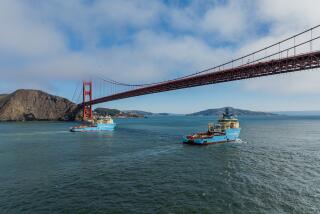No ‘island’ of tsunami debris floating toward U.S., NOAA says
- Share via
The National Oceanic and Atmospheric Administration has been doing some serious myth-busting after news reports this week claimed a massive island of debris from the 2011 Japan tsunami was headed for the U.S. West Coast.
One problem: There is no floating mass of debris.
The disaster swept millions of tons of material out to sea. While some has washed up on the West Coast and Hawaii, what remains afloat is widely scattered across the Pacific.
The source of alarm was a map NOAA posted online without fanfare Sept. 23. The agency has updated the graphic every month or two since developing a debris-tracking computer model shortly after the March 2011 tsunami.
The latest version of NOAA’s graphic shows a blob-shaped zone more than 1,000 miles wide northeast of Hawaii, identifying it as the region with the highest concentration of debris.
Earlier this week, media outlets across the world took notice, warning of a floating island of debris the size of Texas and a “toxic monster” headed for the U.S. West Coast.
“This kind of caught fire,” said Keely Belva, a NOAA spokeswoman who spent Tuesday on the phone clearing up misperceptions about the loosely scattered debris.
A post on the agency’s marine debris blog laid out the reality:
Here’s the bottom line: There is no solid mass of debris from Japan heading to the United States.
At this point, nearly three years after the earthquake and tsunami struck Japan, whatever debris remains floating is very spread out. It is spread out so much that you could fly a plane over the Pacific Ocean and not see any debris since it is spread over a huge area, and most of the debris is small, hard-to-see objects.
NOAA officials said their computer model is not a forecast of where the debris is headed but a “hindcast” that uses winds, ocean currents and weather to show the last area the debris was likely to be.
“It’s kind of a snapshot on that day of where we think the marine debris is,” Belva said. “There’s not an island, but a higher concentration of marine debris versus the rest of the North Pacific.”
Marine debris is one consequence of the magnitude 9.0 earthquake that struck off the coast of Japan on March 11, 2011. The quake triggered tsunami waves over 100 feet high, killed more than 16,000 people and set adrift between 1 and 2 million tons of debris. The material is not radioactive because it was dragged to sea before the nuclear crisis at Fukushima.
Scientists have been tracking that material’s journey across the Pacific Ocean since, as fuel tanks, fishing floats, volleyballs and fishing vessels have drifted for thousands of miles and appeared on U.S. shores. It’s a massive, tragic experiment -- the first time it has been possible to observe so much debris as it disperses from a single point at one time.
NOAA has collected close to 2,000 sightings of tsunami debris from the West Coast and the Hawaiian Islands and confirmed that 35 pieces can be traced back to the tsunami.
Among the confirmed items: a 66-foot floating dock that washed up near Newport, Ore.; a derelict fishing boat found near Crescent City, Calif.; and a soccer ball with Japanese writing discovered on a remote Alaskan island and traced to a 16-year-old boy in Japan.
Where is the debris headed? Government officials can’t say for sure.
More debris could make landfall. It could also join the accumulation of garbage (much of it tiny fragments of plastic) that is already swirling endlessly in slow moving currents in the North Pacific, sometimes called garbage patches or gyres.
“We’d expect some of the tsunami debris to be caught in those areas too,” Peter Murphy with NOAA’s Marine Debris Program wrote in an email. “However, with tsunami debris still arriving in Hawaii and elsewhere, it’s clear the debris is also widely spread out across the N. Pacific.”
If you see anything that might be debris from the tsunami, you can report it by email to DisasterDebris@noaa.gov.
Twitter: @tonybarboza







